1. Money Flowing to International Stocks
From Dave Lutz at Jones Trading In Asia, meanwhile, almost $16bn has flowed into Chinese equities funds, encouraged by Beijing’s reopening after years of stringent coronavirus restrictions. That reopening has also helped in Europe, which is more reliant than the US on exports to China. China accounted for almost half of the $34bn inflows into emerging markets more broadly, according to EPFR
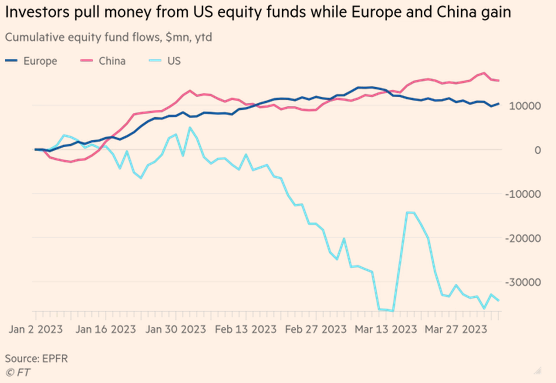
2. History of Nasdaq Bank Index Selloffs
Dragomir Kolev Lessons from prior 20%+ bank sell-offs Over the past 40 years, the NASDAQ Bank Index declined by 20% or more in five sell-offs, as shown below. The average length of those sell-offs was 516 days, and the average peak-to-trough price drop was 47%. The duration of the current sell-off is 447 days, with a 43% decline on April 6 from the 14 January 2022 peak. History suggests that volatility may last a few more months before we reach a bottom, but that bottom is not far from current trading levels. Historically, bank stock rallies have averaged 61% in the 12 months after the bottom is reached.

https:://www.linkedin.com/in/dragomir-kolev-64588120/
3. Triple B CMBS Spreads Over Treasuries
WSJ By Sam Goldfarb As of Wednesday, the average extra yield, or spread, above U.S. Treasurys that investors were demanding to hold CMBS with a triple-B rating—the lowest broad investment-grade tier—was 9.52 percentage points, according to an ICE BofA index. That was up from 7.6 percentage points at the end of February and approaching the 10.8 percentage point level reached in March 2020, when local authorities were issuing stay-at-home orders. The average price of the bonds has dropped to around 75 cents on the dollar from roughly 89 cents a year ago.

https://www.wsj.com/articles/investors-retreat-from-commercial-real-estate-bonds-f4bdf040
4. Credit: The Fed’s emergency facility balances continue to rise.
The emergency facility is designed to help banks meet short-term funding needs, and banks have shied away from using it in recent years.

https://dailyshotbrief.com/
5. Costco Retail Spending Indicator
Three Lower Highs in a Row.
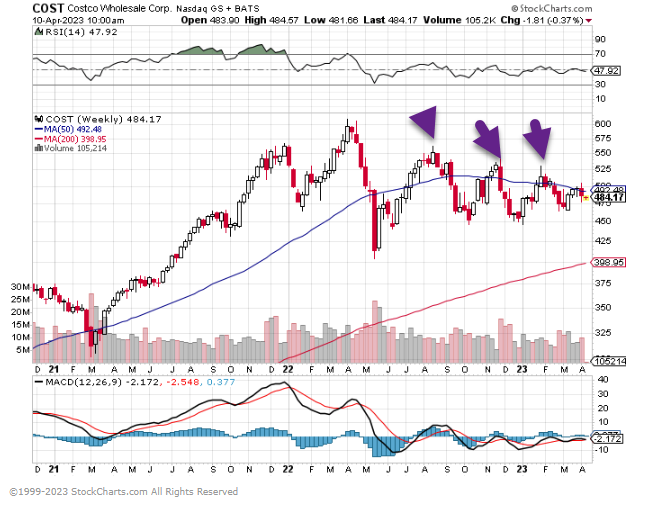
6. Cumulative Layoffs Since October 2022

https://www.bloomberg.com/graphics/2023-layoff-tracker-credit-suisse-ubs-job-cuts/?sref=GGda9y2L
7. Lending Tree Credit Card Data


https://www.lendingtree.com/credit-cards/credit-card-debt-statistics/
8. New Survey Shows That Up To 47% Of U.S. Healthcare Workers Plan To Leave Their Positions By 2025
Jack Kelly Forbes
The Covid-19 pandemic unleashed wave after wave of challenges and feelings of burnout for United States healthcare workers, and unless changes are made to the industry, nearly half plan to leave their current positions, according to a new report examining the work environment and industry’s future for clinicians.
Elsevier Health, a provider of information solutions for science, health and technology professionals, conducted its first “Clinician of the Future” global report. It revealed current pain points, predictions for the future and how the industry can come together to address gaps—including that 31% of clinicians globally, and 47% of U.S. healthcare workers, plan to leave their current role within the next two to three years.
In the new report from Elsevier Health, published two years after the Covid-19 pandemic began, thousands of doctors and nurses from across the globe revealed what is needed to fill gaps and future-proof today’s healthcare system. The comprehensive “Clinician of the Future” report was conducted in partnership with Ipsos and uncovered how undervalued doctors and nurses feel, as well as their call for urgent support, such as more skills training—especially in the effective use of health data and technology—preserving the patient-doctor relationship in a changing digital world and recruiting more healthcare professionals into the field. The multiphase research report not only understands where the healthcare system is following the Covid-19 pandemic, but where it needs to be in 10 years to ensure a future that both providers and patients deserve.
The “Clinician of the Future” report includes a quantitative global survey, qualitative interviews and roundtable discussions with nearly 3,000 practicing doctors and nurses around the world. The data helps shed light on the challenges impacting the profession today and predictions on what healthcare will look like in the next 10 years, according to those providing critical patient care
According to the report, 56% of respondents said that there has been growing empowerment amongst patients within the last 10 years, as people take charge of their health journeys. When referring to soft skills, 82% said that it’s important for them to exhibit active listening and empathy to the people they serve. Furthermore, nearly half of clinicians cite the allocated time they have with patients as an issue, as only 51% believe that the allotted time allows them to provide satisfactory care.
To ensure a positive shift moving into the future and to fill current gaps, clinicians highlight the following priority areas for greater support:
- Clinicians predict that over the next 10 years “technology literacy” will become their most valuable capability, ranking higher than “clinical knowledge.” In fact, 56% of clinicians predict they will base most of their clinical decisions using tools that utilize artificial intelligence. However, 69% report being overwhelmed with the current volume of data and 69% predict the widespread use of digital health technologies to become an even more challenging burden in the future. As a result, 83% believe training needs to be overhauled so they can keep pace with technological advancements.
- Clinicians predict a blended approach to healthcare with 63% saying most consultations between clinicians and patients will be remote and 49% saying most healthcare will be provided in a patient’s home instead of in a healthcare setting. While clinicians may save time and see more patients, thanks to telehealth, more than half of clinicians believe telehealth will negatively impact their ability to demonstrate empathy with patients they no longer see in person. As a result, clinicians are calling for guidance on when to use telehealth and how to transfer soft skills like empathy to the computer screen.
- Clinicians are concerned about a global healthcare workforce shortage, with 74% predicting there will be a shortage of nurses and 68% predicting a shortage of doctors in 10 years’ time. This may be why global clinicians say a top support priority is increasing the number of healthcare workers in the coming decade. Clinicians require the support of larger, better-equipped teams and expanded multidisciplinary healthcare teams, such as data analysts, data security experts and scientists, as well as clinicians themselves.
“While we know that many nurses are leaving the profession due to burnout, we also know that the pandemic has inspired others to enter the field because of a strong desire for purposeful work,” said Marion Broome, Ruby F. Wilson professor of nursing at Duke University’s School of Nursing. “We must embrace this next wave of healthcare professionals and ensure we set them up for success. Our future as a society depends on it.”
Jack Kelly https://www.forbes.com/sites/
9. Americans Losing Faith in Government to Solve Important Problems-Pew Research
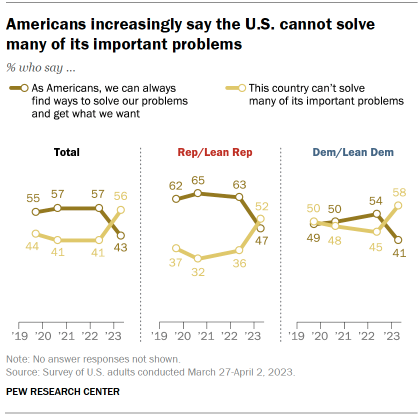
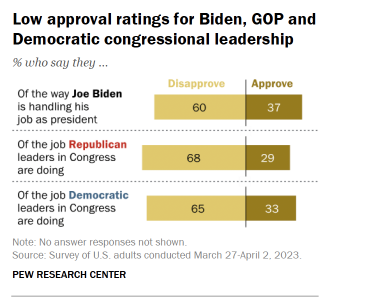
https://www.pewresearch.com.org/politic/2023/04/07/in-divided-washington-americans-have-highly-negative-views-of-both-parties-leaders/
10. Newspaper Delivery Penetration of Population 1950—120%
WSJ When Boys, Not Phones, Delivered the News
Many homes took two papers, a morning and an evening one.
By Bob Greene
I’m no stamp collector, but there is a 3-cent first class stamp, issued in 1952, that I keep in a frame on a bookshelf. The Post Office Department authorized the stamp to honor what the nation considered an essential job.
The rectangular stamp, light purple in color, depicts houses in a typical small town. Against that backdrop is an illustration of a boy with a canvas bag slung over one shoulder. The stamp’s inscription reads: “In recognition of the important service rendered their communities and their nation by America’s newspaperboys.”
I look at that stamp every time there is another news story about the declining circulation of print papers, even as digital circulation grows. Newspaperboys (and girls) were a vital part of the American landscape in the decades before the internet and cable news delivered up-to-the-second bulletins onto people’s screens. Today, print papers mostly are delivered by adults in cars. But that purple stamp celebrated the era when the speediest way of getting news to front doors was a boy on a bike.
How ingrained in the nation’s life was that boy? One proud former newspaperboy—Dwight D. Eisenhower—issued a statement from the White House in 1954 honoring the carriers “not only because they serve our daily family needs, but because they symbolize so many cherished American ideals.”
When Eisenhower mentioned “daily family needs,” he wasn’t being hyperbolic. In 1950 the penetration of American households by newspapers—a statistic measuring in how many homes a newspaper was read each day—was just above 120%. How could the number exceed 100%? Many homes subscribed to two papers—a morning and an evening one.
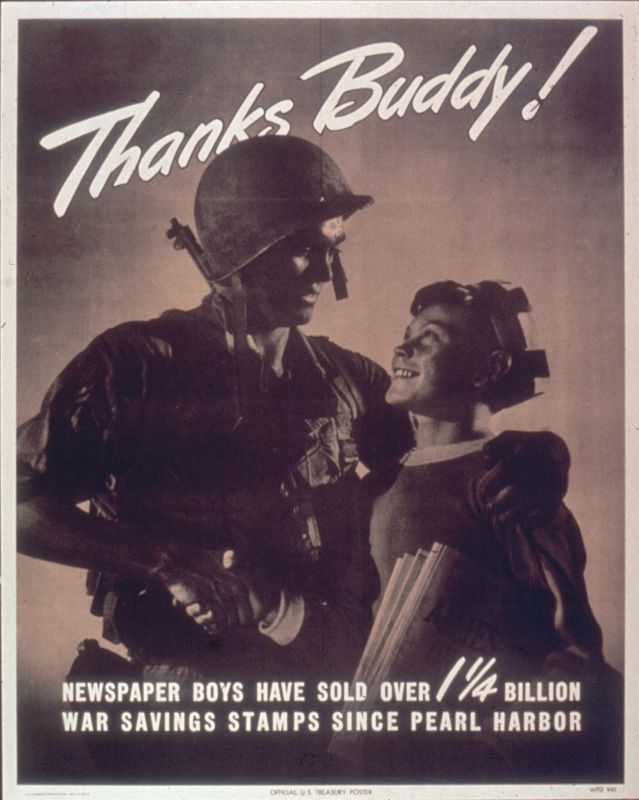
PHOTO: GETTY IMAGES
Part of newspaperboys’ regular duties was to collect by hand, each week or each month, the subscription fees from every home on their route. During World War II, they raised money for the nation’s defense by selling War Bonds and War Stamps as they made their rounds. In appreciation, the U.S. Treasury commissioned a poster featuring a G.I. in combat gear shaking the hand of a newspaperboy. “Thanks Buddy!” the poster proclaimed. “Newspaper Boys have sold over 1¼ billion war savings stamps since Pearl Harbor.”
Some states bestowed annual awards on delivery boys or girls for exemplary work. In Ohio the award was considered so prestigious that it was presented by either the governor or the chief justice of the state supreme court. In 1954 the Bowling Green Sentinel-Tribune explained to its readers that “the newspaperboy completes the job started by the reporter in far-off Asia . . . the photographer in Africa . . . the correspondent in Alaska. . . . But the job is a long way from being finished until the newspaper is in your home.”
For some of us who love this business, there is still no sweeter sound than the solid thump of a rolled-up paper hitting the front stoop. The future may be digital, but to that hardworking newspaperboy on the 3-cent stamp, with gratitude and respect across all the years: Here’s to you.
Mr. Greene’s books include “Late Edition: A Love Story.” https://www.wsj.com/articles/